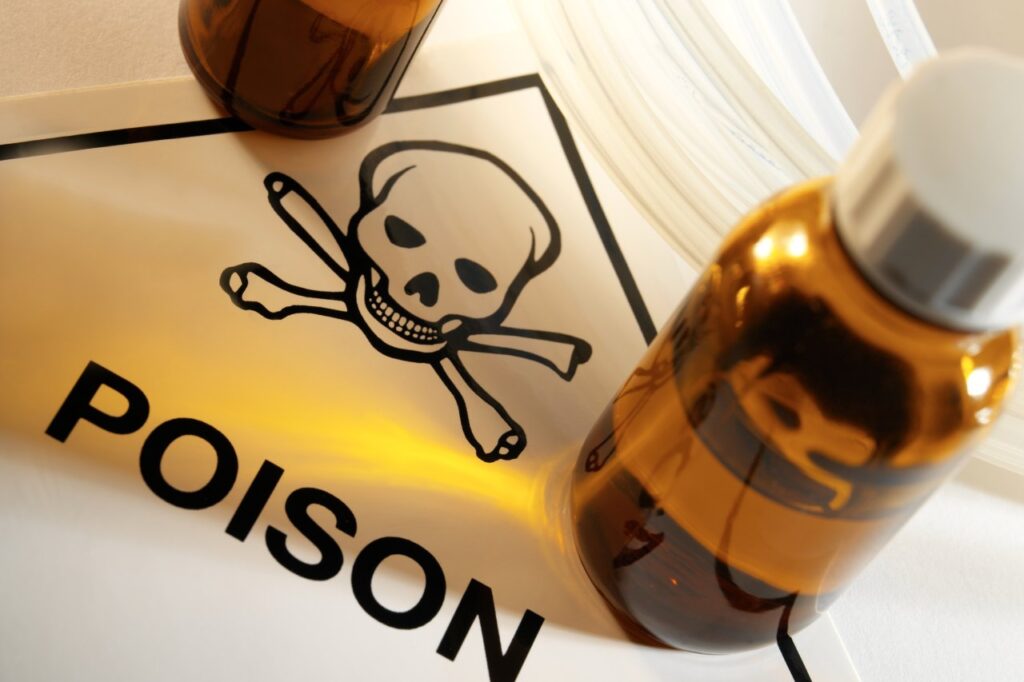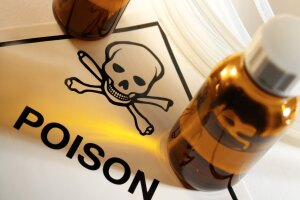Dieser Beitrag ist auch verfügbar auf:
Deutsch
The most treacherous thing about poisoning is that the effect of some poisons only sets in after hours – sometimes even days. At this point, the body has already completely absorbed the poison and can no longer remove it. This is the case with mushroom poisoning, for instance, which can be fatal in many cases. Snake venom, on the other hand, usually acts immediately.
The following symptoms may indicate poisoning
- Nausea, vomiting and diarrhea
- Abdominal pain
- Pale or reddened skin
- Headaches and dizziness
- A sensation of heat in the body
- Confusion and hallucinations
- The heart rate speeds up or slows down
- Shock
- Diminished consciousness up to to unconsciousness
- Shortness of breath up to respiratory arrest
What you should do in case of poisoning
- Call an ambulance immediately. To do so, dial the emergency number for your country, such as 911 for the USA and 999 in the UK.
- Place the victim in the recovery position and, if possible, move the victim to fresh air.
- If the victim is not breathing, perform CPR.
- Under no circumstances should you induce vomiting in the affected person. There is a risk that they will inhale vomit and choke.
- Protect your own health: If gas poisoning is suspected, do not stay in the affected building for too long.
What you should report to the emergency services
- How old is the affected person?
- How much does the affected person weigh?
- What could have caused the poisoning, how much of it could the person have consumed and when?
- How is the affected person feeling? What are their symptoms? Are they responsive?
- Please also provide your telephone number for a potential callback.
This happens when our body becomes poisoned
Poisons can enter the body through the digestive tract (ingestion poisoning), through the respiratory system (inhalation poisoning), and even through the skin (percutaneous poisoning, also called contact poisoning).
Depending on their effects, poisons can damage the function of the brain or nervous system, heart function, circulatory function, or the function of individual organs, up to and including failure. Some toxins target the liver, which is responsible for detoxifying the body, making it a vital organ.
“Many poisons affect multiple areas of the body.” For instance, confusing a fall crocus with wild garlic not only risks serious liver and kidney damage. In addition, it can lead to altered blood clotting and impaired heart and circulatory function. This can cause multiple organs to fail simultaneously, which can be fatal.
Not every toxin is harmful to every organism
Many animals react similarly to toxins that are harmful to humans. But there are exceptions. For instance, birds can easily consume the highly toxic black nightshade, which is lethal to humans. Hedgehogs, too, have evolved immunity to a variety of toxins over the course of evolution – including cyanide and snake venom.
The top three most dangerous toxins found in nature
- Botox: the popular wrinkle relaxer is another deadly toxin. Botox blocks the release of the neurotransmitter acetylcholine in the brain. This can lead to difficulty speaking and swallowing, muscle weakness, difficulty breathing, seizures, and in severe cases, death. The lethal dose for humans is 10 millionths of a gram. The toxin can occur naturally in spoiled canned food.
- Ricin: a highly toxic protein from the seeds of the castor oil plant. It can be lethal at a dose of 0.25 milligrams, whether injected, ingested, or inhaled. Depending on the method of administration, symptoms and their timing may vary before leading to circulatory failure. The poison is not detectable in the body. In 1978, Bulgarian dissident Georgi Markov was administered a lethal dose of ricin in London by secret service agents using a modified umbrella.
- Batrachotoxin: The poison of the poison dart frog genus Phyllobates. It increases the permeability of sodium ions across nerve and muscle cell membranes. As a result, nerve cells can no longer transmit impulses, and muscle cells remain permanently contracted. This, in turn, leads to severe heart rhythm disturbances, ventricular fibrillation, and ultimately heart failure. Hence, Batrachotoxin is also referred to as convulsant poison. Estimates for the lethal dose vary: currently ranging from 1 to 2 milligrams per kilogram of body weight
The top three most dangerous man-made toxins
- VX: Also known as TX 60 or EA 1701. A nerve agent used during the Cold War, derived from a phosphorus acid ester. It interferes with muscle contractions, leading to death by suffocation, as the affected individual is unable to breathe.
- TCDD: This form of dioxin is formed during the production of 2,4,5-trichlorophenoxyacetic acid. It causes the breakdown of liver cells and body deformities such as chloracne. During the Vietnam War, the defoliant Agent Orange was used, which, enriched with TCDD, caused health damage to the population that continues to this day.
- Novichok: A poison developed in the Soviet Union that blocks the enzyme cholinesterase. This leads to overstimulation of the nerves. The result is paralysis of the respiratory muscles or uncontrolled muscle spasms, which can lead to cardiac arrest. The poison is believed to have been used in the attacks on Sergei and Yulia Skripal in 2018 and on the now deceased Kremlin critic Alexei Navalny in 2020. Even skin contact with one milligram of the poison can kill a person.






